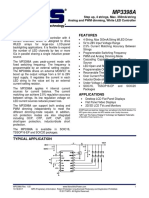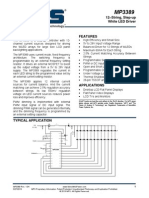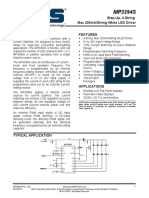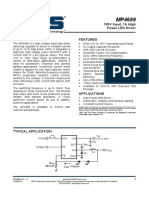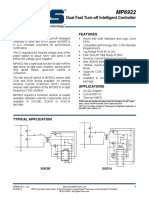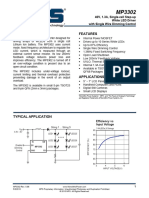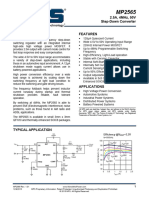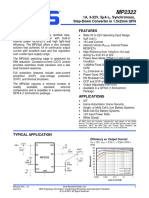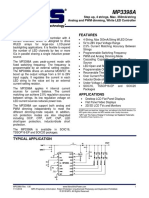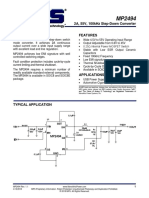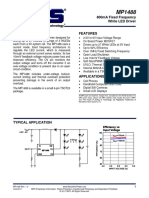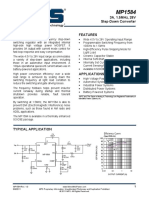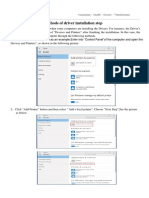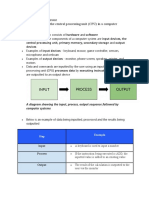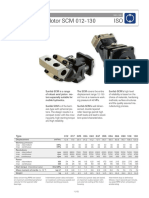MP3398D
Uploaded by
Deryne RMP3398D
Uploaded by
Deryne RMP3398D
4-String, Max 350mA/String, Step-Up,
White LED Controller with
Analog and PWM Dimming
DESCRIPTION FEATURES
The MP3398D is a step-up controller with four • 4-String, 350mA/String Max WLED Driver
current channels designed to drive WLED • 5V-to-28V Input Voltage Range
arrays for large LCD panel backlighting • 2.5% Current Matching Accuracy between
applications. The MP3398D allows for flexible Strings
expansion of the number of LED channels by • Programmable Switching Frequency
two or more ICs in parallel sharing a single • PWM and Analog Dimming Mode
inductive power source. • Cascading Capability with a Single Power
The MP3398D employs peak-current mode with Source
a fixed switching frequency. The frequency is • LED Open and Short LED Protection
programmable by an external setting resistor. • Programmable Over-Voltage Protection
The MP3398D drives an external MOSFET to (OVP)
boost up the output voltage from a 5V to 28V • Recoverable Thermal Shutdown
input supply and can regulate the current in • Over-Current Protection (OCP)
each LED string to the value set by an external • Inductor/Diode Short Protection
current-setting resistor. • Under-Voltage Lockout (UVLO)
The MP3398D applies four internal current • Available in SOIC16 and SOIC20 Packages
sources for current balancing. The current
matching can achieve 2.5% regulation accuracy
APPLICATIONS
between strings. The low regulation voltage on • Desktop LCD Flat-Panel Displays
the LED current sources reduces power loss. • Flat-Panel Video Displays
• 2D/3D LCD TVs and Monitors
The MP3398D can support both analog and
PWM dimming independently to meet different All MPS parts are lead-free, halogen-free, and adhere to the RoHS directive. For
MPS green status, please visit the MPS website under Quality Assurance.
dimming mode requests. Full protection “MPS” and “The Future of Analog IC Technology” are registered trademarks of
features include over-current protection (OCP), Monolithic Power Systems, Inc.
over-temperature protection (OTP), under-
voltage protection (UVP), over-voltage
protection (OVP), LED short/open protection,
and inductor/diode short protection.
The MP3398D is available in SOIC16 and
SOIC20 packages.
TYPICAL APPLICATION
L1 D1 VOUT
VIN
C1 C2
GND
R1
15
VIN GATE 14
C3 R2
16 13
VCC ISENSE
1 R6
4
COMP GND
String 1
String 2
String 3
String 4
R4 2 12
EN MP3398D OVP
C4 5 11
OSC LED1
R5 7 10
ADIM LED2
3
9
PWM LED3
6 8
ISET LED4
R3
MP3398D Rev. 1.0 www.MonolithicPower.com 1
5/23/2016 MPS Proprietary Information. Patent Protected. Unauthorized Photocopy and Duplication Prohibited.
© 2016 MPS. All Rights Reserved.
MP3398D – 4-STRING, 350MA/STRING, STEP-UP, WHITE LED CONTROLLER
ORDERING INFORMATION
Part Number Package Top Marking
MP3398DGS* SOIC16
See Below
MP3398DGY** SOIC20
* For Tape & Reel, add suffix –Z (e.g. MP3398DGS–Z)
** For Tape & Reel, add suffix –Z (e.g. MP3398DGY–Z)
TOP MARKING (MP3398DGS)
MPS: MPS prefix
YY: Year code
WW: Week code
MP3398D: Part number
LLLLLLLLL: Lot number
PACKAGE REFERENCE
TOP VIEW TOP VIEW
COMP 1 16 VCC
EN 2 15 VIN
PWM 3 14 GATE
GND 4 13 ISENSE
OSC 5 12 OVP
ISET 6 11 LED1
ADIM 7 10 LED2
LED4 8 9 LED3
SOIC16 SOIC20
MP3398D Rev. 1.0 www.MonolithicPower.com 2
5/23/2016 MPS Proprietary Information. Patent Protected. Unauthorized Photocopy and Duplication Prohibited.
© 2016 MPS. All Rights Reserved.
MP3398D – 4-STRING, 350MA/STRING, STEP-UP, WHITE LED CONTROLLER
ABSOLUTE MAXIMUM RATINGS (1) Thermal Resistance
(4)
θJA θJC
VIN .............................................. -0.3V to +30V SOIC16………………………… 80….. 35....... °C/W
VGATE ........................................... -0.3V to +6.5V SOIC20...................…………. 72...... 30....... °C/W
VCC ............................................ -0.3V to +6.8V
NOTES:
VLED1 to VLED4 .................................. -1V to +55V 1) Exceeding these ratings may damage the device. The voltage
VISENSE ......................................... -0.5V to +6.5V is measured with a 20MHz bandwidth limited oscilloscope.
All other pins ................................. -0.3V to VCC 2) The maximum allowable power dissipation is a function of the
(2) maximum junction temperature TJ (MAX), the junction-to-
Continuous power dissipation (TA = 25°C) ambient thermal resistance θJA, and the ambient temperature
SOIC16…………………………………….. 1.56W TA. The maximum allowable continuous power dissipation at
any ambient temperature is calculated by PD (MAX) = (TJ
SOIC20……………………………………..1.74W (MAX)-TA)/θJA. Exceeding the maximum allowable power
Junction temperature ............................... 150°C dissipation produces an excessive die temperature, causing
the regulator to go into thermal shutdown. Internal thermal
Lead temperature .................................... 260°C shutdown circuitry protects the device from permanent
ESD capability human body mode (all pins) damage.
................................................................. 3.5kV 3) The device is not guaranteed to function outside of its
operating conditions.
(3) 4) Measured on JESD51-7, 4-layer PCB.
Recommended Operating Conditions
Supply voltage (VIN) .......................... 5V to 28V
LED current (backlight) ............10mA to 350mA
Operating junction temp. (TJ). .. -40°C to +125°C
MP3398D Rev. 1.0 www.MonolithicPower.com 3
5/23/2016 MPS Proprietary Information. Patent Protected. Unauthorized Photocopy and Duplication Prohibited.
© 2016 MPS. All Rights Reserved.
MP3398D – 4-STRING, 350MA/STRING, STEP-UP, WHITE LED CONTROLLER
ELECTRICAL CHARACTERISTICS
VIN = 12V, VEN = 5V, TA = 25°C, unless otherwise noted.
Parameters Symbol Condition Min Typ Max Units
Operating input voltage VIN 5 28 V
VIN = 12V, VEN = 5V,
Supply current (quiescent) IQ 1.2 1.35 1.5 mA
no load without switching
VIN = 12V, VEN = 5V,
Supply current (operation) IOP 3 5.5 mA
no load with switching
Supply current (shutdown) IST VEN = 0V, VIN = 12V 0.01 0.5 μA
VEN = 5V, 7V < VIN < 28V,
LDO output voltage VCC 5.4 6 6.6 V
0 < IVCC < 10mA
VCC UVLO threshold VIN_UVLO Rising edge 3.6 4 4.4 V
VCC UVLO hysteresis 200 mV
EN high voltage VEN_HIGH VEN rising 1.4 V
EN low voltage VEN_LOW VEN falling 0.6 V
Step-Up Converter
Gate driver impedance
VCC = 6V, VGATE = 6V 4.5 7 Ω
(sourcing)
Gate driver impedance (sinking) VCC = 6V, IGATE = 10mA 2.5 5 Ω
ROSC = 115kΩ 459 540 621 kHz
Switching frequency fSW
ROSC = 374kΩ 150 180 210 kHz
OSC voltage VOSC 1.20 1.23 1.26 V
Maximum duty cycle DMAX ROSC = 115kΩ 90 93 %
Cycle-by-cycle ISENSE current
Max duty cycle 175 220 265 mV
limit
COMP source current limit ICOMP SOLI 1V < COMP < 1.9V 70 μA
COMP sink current limit ICOMP SILI 1V < COMP < 1.9V 17 μA
COMP transconductance GCOMP ∆ICOMP = ±10μA 400 μA/V
Current Dimming
PWM input low threshold VPWM_LO VPWM falling 0.6 V
PWM input high threshold VPWM_HI VPWM rising 1.4 V
ADIM input low threshold VADIM_LO VADIM falling 0.6 V
ADIM input high threshold VADIM_HI VADIM rising 1.4 V
MP3398D Rev. 1.0 www.MonolithicPower.com 4
5/23/2016 MPS Proprietary Information. Patent Protected. Unauthorized Photocopy and Duplication Prohibited.
© 2016 MPS. All Rights Reserved.
MP3398D – 4-STRING, 350MA/STRING, STEP-UP, WHITE LED CONTROLLER
ELECTRICAL CHARACTERISTICS (continued)
VIN = 12V, VEN = 5V, TA = 25°C, unless otherwise noted.
Parameters Symbol Condition Min Typ Max Units
LED Current Regulation
ISET voltage VISET 1.22 1.24 1.26 V
RISET = 30.5kΩ 31.9 32.9 33.9 mA
LEDX average current ILED RISET = 8.87kΩ,
5.3 5.7 6.2 mA
FADIM = 20kHz, DADIM = 5%
RISET = 30.5kΩ,
2.5 %
(5) ILED = 32.9mA, FPWM = 100%
Current matching
RISET = 8.87kΩ
2.5 %
FADIM = 20kHz, DADIM = 5%
VCC max current limit ICC_Limit 50 75 100 mA
LED MOSFET resistance RLED ILED = 10mA 1.7 Ω
ILED = 330mA 800 mV
LEDX regulation voltage VLEDX
ILED = 60mA 285 mV
Protection
OVP threshold VOVP_OV Rising edge 1.20 1.23 1.26 V
OVP threshold hysteresis VOVP_HYS Hysteresis 80 mV
OVP UVLO threshold VOVP_UV Step-up converter fails 30 75 120 mV
LEDX UVLO threshold VLEDX_UV 120 200 280 mV
LEDX over-voltage threshold VLEDX_OV 5.8 6.3 6.8 V
LED short fault cycles TLED_OV 4096
Latch-off current limit VLMT 560 640 720 mV
(6)
Thermal protection threshold TST 150 °C
Thermal protection hysteresis 25 °C
NOTE:
5) Matching is defined as the difference of the maximum to minimum current divided by 2 times average currents.
6) Guarantee by design.
MP3398D Rev. 1.0 www.MonolithicPower.com 5
5/23/2016 MPS Proprietary Information. Patent Protected. Unauthorized Photocopy and Duplication Prohibited.
© 2016 MPS. All Rights Reserved.
MP3398D – 4-STRING, 350MA/STRING, STEP-UP, WHITE LED CONTROLLER
TYPICAL PERFORMANCE CHARACTERISTICS
MP3398D Rev. 1.0 www.MonolithicPower.com 6
5/23/2016 MPS Proprietary Information. Patent Protected. Unauthorized Photocopy and Duplication Prohibited.
© 2016 MPS. All Rights Reserved.
MP3398D – 4-STRING, 350MA/STRING, STEP-UP, WHITE LED CONTROLLER
TYPICAL PERFORMANCE CHARACTERISTICS (continued)
VIN = 12V, VOUT = 30V, L = 33µH, ILED = 120mA/String, 4 strings, TA = 25°C, unless otherwise noted.
MP3398D Rev. 1.0 www.MonolithicPower.com 7
5/23/2016 MPS Proprietary Information. Patent Protected. Unauthorized Photocopy and Duplication Prohibited.
© 2016 MPS. All Rights Reserved.
MP3398D – 4-STRING, 350MA/STRING, STEP-UP, WHITE LED CONTROLLER
TYPICAL PERFORMANCE CHARACTERISTICS (continued)
VIN = 12V, VOUT = 30V, L = 33µH, TA = 25°C, unless otherwise noted.
MP3398D Rev. 1.0 www.MonolithicPower.com 8
5/23/2016 MPS Proprietary Information. Patent Protected. Unauthorized Photocopy and Duplication Prohibited.
© 2016 MPS. All Rights Reserved.
MP3398D – 4-STRING, 350MA/STRING, STEP-UP, WHITE LED CONTROLLER
PIN FUNCTIONS
SOIC16 SOIC20
Name Description
Pin # Pin #
Step-up converter compensation. COMP compensates for the regulation
1 1 COMP
control loop. Connect a ceramic capacitor from COMP to GND.
Enable control input. A voltage on EN greater than 1.4V turns the MP3398D
2 2 EN
on; a voltage less than 0.6V turns the MP3398D off. Do not leave EN floating.
Input signal for PWM brightness control. By applying a PWM signal on
PWM, the LED current can be chopped, and the average current equals ISET x
DDIM, where ISET is the LED current value set by a resistor connected to PIN 6,
and DDIM is the duty cycle of the PWM dimming duty cycle.
Ensure that the PWM amplitude voltage level is greater than VPWM_HI and the
3 3 PWM low-level voltage is less than VPWM_LO. The input PWM signal frequency mainly
determines the LED current dimming ratio. A lower dimming frequency can
result in a smaller dimming current. In general, 200Hz to 2kHz is suitable for
most LED current dimming applications. If PWM is floating, weakly pull it to
GND internally. If PWM dimming is not required, pull PWM to a high voltage
(1.4V < VPWM < 5V).
4 5 GND Ground of the IC.
Switching frequency set. Connect a resistor between OSC and GND to set
5 7 OSC the step-up converter switching frequency. The OSC voltage is regulated to
1.23V. The clock frequency is proportional to the current sourced from OSC.
LED current set. Tie a current-setting resistor from ISET to ground to program
6 8 ISET the current in each LED string. The ISET voltage is regulated to 1.24V. The
LED current is proportional to the current through the ISET resistor.
Signal input for analog brightness control. The LED current amplitude is
determined by ADIM, and the input signal is a PWM signal. An internal R-C filter
(10MΩ resistor and 100pF capacitor) is integrated into ADIM. If a PWM signal is
applied to ADIM, a frequency greater than 20kHz is recommended to achieve
7 9 ADIM
better PWM signal filtering and ensure that the amplitude voltage is higher than
1.4V and the low-level voltage is less than 0.6V. If ADIM is floating, weakly pull
it to GND internally. If analog dimming is not required, pull ADIM to a high
voltage (1.4V < VADIM < 5V).
LED string 4 current input. LED4 is the open-drain output of an internal
8 10 LED4
dimming-control switch. Connect the LED string 4 cathode to LED4.
LED string 3 current input. LED3 is the open-drain output of an internal
9 11 LED3
dimming control switch. Connect the LED string 3 cathode to LED3.
LED string 2 current input. LED2 is the open-drain output of an internal
10 12 LED2
dimming control switch. Connect the LED string 2 cathode to LED2.
LED string 1 current input. LED1 is the open-drain output of an internal
11 13 LED1
dimming control switch. Connect the LED string 1 cathode to LED1.
Over-voltage protection input. Connect a resistor divider from the output to
12 14 OVP OVP to program the OVP threshold. When the OVP voltage reaches 1.23V, the
MP3398D triggers over-voltage protection.
MP3398D Rev. 1.0 www.MonolithicPower.com 9
5/23/2016 MPS Proprietary Information. Patent Protected. Unauthorized Photocopy and Duplication Prohibited.
© 2016 MPS. All Rights Reserved.
MP3398D – 4-STRING, 350MA/STRING, STEP-UP, WHITE LED CONTROLLER
PIN FUNCTIONS (continued)
SOIC16 SOIC20
Name Description
Pin # Pin #
Current sense input. During normal operation, ISENSE senses the voltage
across the external inductor current-sensing resistor (RSENSE) for peak-current-
13 17 ISENSE mode control and to limit the inductor current during every switching cycle. If
ISENSE is not used for cascading applications, tie it to GND. Do not leave
ISENSE floating.
Step-up converter power switch gate output. GATE drives the external
14 18 GATE
power N-channel MOSFET device.
Supply input. VIN supplies power to the chip and the step-up converter switch.
15 19 VIN
Drive VIN with a 5V-to-28V power source. Must be bypassed locally.
Internal 6V linear regulator output. VCC provides a power supply for the
16 20 VCC external MOSFET switch gate driver and the internal control circuitry. Bypass
VCC to GND with a ceramic capacitor.
4, 6,
NC No connection.
15, 16
MP3398D Rev. 1.0 www.MonolithicPower.com 10
5/23/2016 MPS Proprietary Information. Patent Protected. Unauthorized Photocopy and Duplication Prohibited.
© 2016 MPS. All Rights Reserved.
MP3398D – 4-STRING, 350MA/STRING, STEP-UP, WHITE LED CONTROLLER
BLOCK DIAGRAM
Figure 1: Functional Block Diagram
MP3398D Rev. 1.0 www.MonolithicPower.com 11
5/23/2016 MPS Proprietary Information. Patent Protected. Unauthorized Photocopy and Duplication Prohibited.
© 2016 MPS. All Rights Reserved.
MP3398D – 4-STRING, 350MA/STRING, STEP-UP, WHITE LED CONTROLLER
OPERATION The output voltage of the internal error amplifier
is an amplified signal of the difference between
The MP3398D is a step-up converter with peak-
the reference voltage and the feedback voltage.
current mode control. It employs four channels
The converter chooses the lowest active LEDX
of current sources to drive up to four strings of
pin voltage automatically to provide a sufficient
white LEDs.
bus voltage to power all of the LED arrays.
Internal 6V Regulator
If the feedback voltage drops below the
The MP3398D includes an internal linear reference, the output of the error amplifier
regulator (VCC). When VIN is greater than increases. This results in more current flowing
6.5V, this regulator outputs a 6V power supply through the MOSFET, increasing the power
to the external MOSFET switch-gate driver and delivered to the output and forming a closed
the internal control circuitry. The VCC voltage loop that regulates the output voltage.
drops to 0V when the chip shuts down. The
MP3398D also has under-voltage lockout Under light-load operation, especially in the
(UVLO). The chip is disabled until VCC case of VOUT ≈ VIN, the converter runs in pulse-
exceeds the UVLO threshold. The UVLO skipping mode. In this mode, the MOSFET
hysteresis is approximately 200mV. turns on for a minimum on time of
approximately 200ns, and then the converter
System Start-Up discharges the power to the output for the
When enabled, the MP3398D checks the remaining period. The external MOSFET
topology connection first. The chip monitors the remains off until the output voltage needs to be
over-voltage protection (OVP) to determine if boosted again.
the Schottky diode is not connected or if the
boost output is shorted to GND. An OVP Dimming Control
voltage less than 75mV will disable the chip. The MP3398D provides two dimming methods:
PWM and analog dimming mode.
The MP3398D also checks other safety limits
after passing the OVP test, including UVLO, For PWM dimming, apply a PWM signal to
over-temperature protection (OTP), and over- PWM. The LED current is chopped by this
current protection (OCP). If all protection tests signal, and the average LED current is equal to
pass, the chip starts boosting the step-up ISET x DDIM, where ISET is the LED current
converter with an internal soft start. amplitude and DDIM is the duty cycle of the
PWM dimming signal.
It is recommended that the enable signal occurs
after the establishment of the input voltage and For analog dimming, a PWM signal is applied to
the PWM dimming signal during the start-up ADIM. When a PWM signal is applied to ADIM,
sequence to prevent a large inrush current. this signal is filtered by the internal RC filter.
The LED current amplitude is equal to ISET x
Step-Up Converter
DDIM, where ISET is the LED current amplitude
The converter operating frequency is and DDIM is the duty cycle of the PWM dimming
programmable from 100kHz to 500kHz with an signal. A PWM signal 20kHz or higher is
external resistor connected to OSC. This helps recommended for better filtering.
optimize efficiency and the size of the external
components.
At the beginning of each switching cycle, the
internal clock turns on the external MOSFET.
During normal operation, the minimum turn on
time is 200ns. A stabilizing ramp added to the
output of the current sense amplifier prevents
subharmonic oscillations for duty cycles greater
than 50%. This result is fed into the PWM
comparator. When this resulting voltage
reaches the output voltage of the error amplifier
(VCOMP), the external MOSFET turns off.
MP3398D Rev. 1.0 www.MonolithicPower.com 12
5/23/2016 MPS Proprietary Information. Patent Protected. Unauthorized Photocopy and Duplication Prohibited.
© 2016 MPS. All Rights Reserved.
MP3398D – 4-STRING, 350MA/STRING, STEP-UP, WHITE LED CONTROLLER
Open-String Protection Inductor and Diode Short Protection
Open-string protection is achieved through the To protect the IC and external MOSFET from
OVP and LEDX (1 to 4) pins. If one or more damage caused when the external inductor is
strings are open, the respective LEDX pins are shorted, the MP3398D uses two protection
pulled to ground, and the IC continues charging mode methods.
the output voltage until it reaches the OVP
The first method occurs when the inductor is
threshold. If the OVP point has been triggered
shorted. The output is unable to maintain
for more than 4µs, the chip stops switching and
enough energy to load the LED, causing the
marks the strings that have an LEDX pin
output voltage to drop. Thus, the COMP voltage
voltage lower than 200mV. Once marked, the
(error amplifier output) rises until it is clamped
remaining LED strings force the output voltage
high. When the COMP voltage lasts for more
back into tight regulation. The string with the
than 512 switching cycles, the IC turns off and
largest voltage drop determines the output
latches.
regulation.
The second method occurs in cases where the
The MP3398D always attempts to light at least
COMP voltage cannot be clamped high when
one string. If all strings are open, the MP3398D
the inductor is shorted. The IC detects the
shuts down the step-up converter. The strings
current flowing through the power MOSFET.
remain in this marked state until the chip resets.
When the current sense voltage across the
Short-String Protection sense resistor (connected between MOSFET
The MP3398D monitors the LEDX pin voltages and GND) reaches the VLMT value and lasts for
to determine if a short-string fault has occurred. four switching cycles, the IC turns off and
If one or more strings are shorted, the latches.
respective LEDX pins tolerate high voltage Thermal Shutdown
stress. If an LEDX pin voltage is higher than
To prevent the IC from operating at exceedingly
6.3V, this condition triggers the detection of a
high temperatures, the MP3398D implements
short string. When a short-string fault (LEDX
thermal shutdown by detecting the silicon die
over-voltage fault) remains for 4096 switching
temperature. When the die temperature
cycles, the fault string is marked off and
exceeds the upper threshold (TST), the IC shuts
disabled. Once a string is marked off, it
down and resumes normal operation when the
disconnects from the output voltage loop. The
die temperature drops below the lower
marked LED strings shut off completely until the
threshold. Typically, the hysteresis value is
part restarts. Short LED protection can be
25°C.
mistriggered by two events: when open LED
protection is triggered, or when the PWM duty
on ADIM goes from high to low in a short
amount of time. To prevent this, the short LED
protection function is disabled when VLEDX of all
of the working LED channels are higher than
1.5V.
MP3398D Rev. 1.0 www.MonolithicPower.com 13
5/23/2016 MPS Proprietary Information. Patent Protected. Unauthorized Photocopy and Duplication Prohibited.
© 2016 MPS. All Rights Reserved.
MP3398D – 4-STRING, 350MA/STRING, STEP-UP, WHITE LED CONTROLLER
APPLICATION INFORMATION Choose an inductor that will not saturate under
worst-case load conditions. Select a minimum
Selecting the Switching Frequency inductor value that ensures that the boost
The switching frequency of the step-up converter converter works in continuous conduction mode
is recommended to be between 100kHz and with high efficiency and good EMI performance.
500kHz for most applications. An oscillator
Calculate the required inductance value using
resistor on OSC sets the internal oscillator
Equation (3) and Equation (4):
frequency for the step-up converter according to
Equation (1): ηV
× ×D (1
× D)
− 2
L≥ OUT
(3)
67320 2 × fSW × ILOAD
FSW (kHz) = (1)
ROSC (kW)
VIN
When ROSC = 374kΩ, the switching frequency is D= 1 − (4)
VOUT
set to 180kHz.
Setting the LED Current Where VIN is the input voltage, VOUT is the output
voltage, fSW is the switching frequency, ILOAD is
Each LED string current can be set through the the LED load current, and η is the efficiency.
current setting resistor on ISET and can be
calculated with Equation (2): The switching current is used for peak-current-
mode control, typically. To avoid hitting the
810 × 1.24(V) current limit, the voltage across the sensing
ILED (mA) = (2)
RISETΩ)
(k resistor (RSENSE) must measure less than 80% of
the worst-case current-limit voltage (VSENSE).
When RISET = 8.37kΩ, the LED current is set to Calculate RSENSE and IL(PEAK) with Equation (5)
120mA. Do not leave ISET open. and Equation (6):
Selecting the Input Capacitor 0.8 × VSENSE
The input capacitor reduces the surge current RSENSE = (5)
IL(PEAK)
drawn from the input supply and the switching
noise from the device. The input capacitor VOUT × ILOAD VIN × (VOUT − VIN )
impedance at the switching frequency should be =
IL(PEAK) + (6)
ηVIN 2 × L × FSW × VOUT
less than the input source impedance to prevent
the high-frequency switching current from Where IL(PEAK) is the peak value of the inductor
passing through to the input. Ceramic capacitors current. VSENSE is shown in Figure 2.
with X5R or X7R dielectrics are recommended
for their low ESR and small temperature
coefficients. For most applications, use a 4.7μF
ceramic capacitor in parallel with a 220µF
electrolytic capacitor.
Selecting the Inductor and Current Sensing
Resistor
The MP3398D requires an inductor to supply a
higher output voltage while being driven by the
input voltage. A larger value inductor results in
less ripple current, resulting in lower peak
inductor current and reducing stress on the N-
channel MOSFET. However, the larger value
inductor also has a larger physical size, higher Figure 2: VSENSE vs. Duty Cycle
series resistance, and lower saturation current.
MP3398D Rev. 1.0 www.MonolithicPower.com 14
5/23/2016 MPS Proprietary Information. Patent Protected. Unauthorized Photocopy and Duplication Prohibited.
© 2016 MPS. All Rights Reserved.
MP3398D – 4-STRING, 350MA/STRING, STEP-UP, WHITE LED CONTROLLER
Selecting the Power MOSFET Please note that calculating the switching loss is
The MP3398D is capable of driving a wide the most difficult part in loss estimation. The
variety of N-channel power MOSFETs. The formula above provides a simplified equation. For
critical parameters for selecting a MOSFET are more accurate estimates, the equation becomes
maximum drain-to-source voltage (VDS(MAX)), much more complex.
maximum current (ID(MAX)), on-resistance (RDS(ON)), The total gate charge (QG) is used to calculate
gate-source charge (QGS) and gate-drain charge the gate drive loss and can be calculated with
(QGD), and total gate charge (QG). Equation (11):
Ideally, the off-state voltage across the MOSFET PDR = Q G × VDR × f SW (11)
should equal the output voltage. Considering the
voltage spike when the MOSFET turns off, Where VDR is the drive voltage.
VDS(MAX) should be greater than 1.5 times the
Selecting the Output Capacitor
output voltage.
The output capacitor keeps the output voltage
The maximum current through the power ripple small and ensures feedback loop stability.
MOSFET occurs at the minimum input voltage The output capacitor impedance must be low at
and the maximum output power. The maximum the switching frequency. Ceramic capacitors with
RMS current through the MOSFET is given by X7R dielectrics are recommended for their low
Equation (7): ESR characteristics. For most applications, a
= IIN(MAX) × DMAX
IRMS(MAX) (7) 4.7μF ceramic capacitor in parallel with a 22μF
electrolytic capacitor is sufficient.
DMAX can be calculated with Equation (8):
Setting the Over-Voltage Protection (OVP)
V − VIN(MIN)
DMAX ≈ OUT (8) Open-string protection is achieved through the
VOUT detection of the voltage on the OVP pin. In some
The current rating of the MOSFET should be cases, an LED string failure results in the
greater than 1.5 times IRMS. The on resistance of feedback voltage always being zero. The part
the MOSFET determines the conduction loss, then continues boosting the output voltage higher
which is given by Equation (9): and higher. If the output voltage reaches the
programmed OVP threshold, the protection is
Pcond = IRMS × R DS (ON) × k
2
(9) triggered.
Where k is the temperature coefficient of the To ensure that the chip functions properly, select
MOSFET. the resistor values for the OVP resistor divider to
The switching loss is related to QGD and QGS1, provide an appropriate set voltage. The
which determine the commutation time. QGS1 is recommended OVP point is about 1.1 to 1.2
the charge between the threshold voltage and times higher than the output voltage for normal
the plateau voltage when a driver charges the operation. The OVP voltage can be calculated
gate, which can be read in the VGS vs. QG chart in with Equation (12):
the MOSFET datasheet. QGD is the charge during RHIGH
the plateau voltage. These two parameters are VOVP= 1.23 × (1 + ) (12)
needed to estimate the turn-on and turn-off RLOW
losses, and can be calculated with Equation (10):
Q GS1 × R G
PSW = × VDS × IIN × f SW +
VDR − VTH
(10)
Q GD × R G
× VDS × IIN × f SW
VDR − VPLT
Where VTH is the threshold voltage, VPLT is the
plateau voltage, RG is the gate resistance, and
VDS is the drain-source voltage.
MP3398D Rev. 1.0 www.MonolithicPower.com 15
5/23/2016 MPS Proprietary Information. Patent Protected. Unauthorized Photocopy and Duplication Prohibited.
© 2016 MPS. All Rights Reserved.
MP3398D – 4-STRING, 350MA/STRING, STEP-UP, WHITE LED CONTROLLER
Selecting the Dimming Control Mode PCB Layout Guidelines
The MP3398D provides two different dimming Efficient PCB layout is critical for stable
methods: direct and analog. operation. The circuit layout for the MP3398D
requires special attention to reduce EMI noise.
1. Direct PWM Dimming
For best results, refer to Figure 3 and follow the
An external PWM dimming signal is employed to guidelines below.
achieve PWM dimming control. Apply a PWM
1. Keep the loop from the external MOSFET
dimming signal between 200Hz to 20kHz to
(M1), through the output diode (D1) and the
PWM. The minimum recommended amplitude of
output capacitor (C2, C3) as small and short
the PWM signal is 1.4V, and the low level should
as possible, since it carries a high-frequency
be less than 0.6V (see Table 1).
pulse current.
Table 1: The Range of PWM Dimming Duty 2. Separate the power ground (PGND) and
fPWM (Hz) Dmin Dmax signal ground (GND).
100 < f ≤ 200 0.30% 100%
3. Connect PGND and GND together to reduce
200 < f ≤ 500 0.75% 100%
noise. All logic signals refer to the signal
500 < f ≤ 1k 1.50% 100%
ground.
1k < f ≤ 2k 3.00% 100%
2k < f ≤ 5k 7.50% 100%
5k < f ≤ 10k 15.00% 100%
10k < f ≤ 20k 30.00% 100%
2. Analog Dimming
For analog dimming, apply a PWM signal to
ADIM. An internal RC filter (10MΩ resistor and
100pF capacitor) is integrated into ADIM. If a
PWM signal is applied to ADIM, use a frequency
greater than 20kHz to achieve a better PWM
signal filtering performance and ensure that the
amplitude voltage is higher than 1.4V and the low
level voltage is less than 0.6V.
Expanding LED Channels Figure 3: Layout Consideration
The MP3398D can expand the number of LED
channels by using two or three devices in
parallel. To connect two MP3398D devices for a
total of eight LED strings, tie the VCC pins of the
master IC and the slave IC together to power the
slave IC internal logic circuitry. Tie the COMP
pins of the slave IC and the master IC together to
regulate the voltage of all eight LED strings. The
slave IC MOSFET driving signals are not used;
the boost converter can only be driven by the
master IC. Do not leave ISENSE of the slave IC
floating; tie it to ground. Apply the EN and DIM
signals to both ICs.
MP3398D Rev. 1.0 www.MonolithicPower.com 16
5/23/2016 MPS Proprietary Information. Patent Protected. Unauthorized Photocopy and Duplication Prohibited.
© 2016 MPS. All Rights Reserved.
MP3398D – 4-STRING, 350MA/STRING, STEP-UP, WHITE LED CONTROLLER
TYPICAL APPLICATION CIRCUIT
Figure 4: 4-String, 12 LEDs in Series, 120mA/String Application
NOTE:
Some components are reasonably adjustable based on real cases.
MP3398D Rev. 1.0 www.MonolithicPower.com 17
5/23/2016 MPS Proprietary Information. Patent Protected. Unauthorized Photocopy and Duplication Prohibited.
© 2016 MPS. All Rights Reserved.
MP3398D – 4-STRING, 350MA/STRING, STEP-UP, WHITE LED CONTROLLER
PACKAGE INFORMATION
SOIC16
MP3398D Rev. 1.0 www.MonolithicPower.com 18
5/23/2016 MPS Proprietary Information. Patent Protected. Unauthorized Photocopy and Duplication Prohibited.
© 2016 MPS. All Rights Reserved.
MP3398D – 4-STRING, 350MA/STRING, STEP-UP, WHITE LED CONTROLLER
PACKAGE INFORMATION (continued)
SOIC20
0.496(12.60) 0.024 0.050
0.512(13.00) (0.61) (1.27)
20 11
0.079
(2.00)
0.291 0.394
(7.40) (10.00) 0.370
0.299 0.418 (9.40)
(7.60) (10.60)
PIN 1 ID
1 10
TOP VIEW RECOMMENDED LAND PATTERN
0.093(2.35)
0.104(2.65) 0.009(0.23)
SEATING PLANE
0.013(0.33)
0.013(0.33) 0.050(1.27) 0.004(0.10)
0.020(0.51) BSC 0.012(0.30) SEE DETAIL "A"
FRONT VIEW SIDE VIEW
0.010(0.25)
x 45o NOTE:
0.030(0.75)
GAUGE PLANE 1) CONTROL DIMENSION IS IN INCHES. DIMENSION IN
0.010(0.25) BSC BRACKET IS IN MILLIMETERS.
2) PACKAGE LENGTH DOES NOT INCLUDE MOLD FLASH ,
PROTRUSIONS OR GATE BURRS.
3) PACKAGE WIDTH DOES NOT INCLUDE INTERLEAD FLASH
0.016(0.41) OR PROTRUSIONS.
0o-8o 4) LEAD COPLANARITY(BOTTOM OF LEADS AFTER FORMING)
0.050(1.27)
SHALL BE 0.10 MILLIMETERS MAX.
5) DRAWING CONFORMS TO JEDEC MS-013, VARIATION AC.
DETAIL "A" 6) DRAWING IS NOT TO SCALE.
NOTICE: The information in this document is subject to change without notice. Please contact MPS for current specifications.
Users should warrant and guarantee that third party Intellectual Property rights are not infringed upon when integrating MPS
products into any application. MPS will not assume any legal responsibility for any said applications.
MP3398D Rev. 1.0 www.MonolithicPower.com 19
5/23/2016 MPS Proprietary Information. Patent Protected. Unauthorized Photocopy and Duplication Prohibited.
© 2016 MPS. All Rights Reserved.
You might also like
- MP3398A - r1.05 Driver Les Board Flaco BellohorizonteNo ratings yetMP3398A - r1.05 Driver Les Board Flaco Bellohorizonte20 pages
- Description Features: The Future of Analog IC TechnologyNo ratings yetDescription Features: The Future of Analog IC Technology20 pages
- 4-String, Max 400mA/String, 80V Return, Step-Up, WLED ControllerNo ratings yet4-String, Max 400mA/String, 80V Return, Step-Up, WLED Controller17 pages
- Step-Up, 4-String Max 200mA/String White LED Driver: The Future of Analog IC TechnologyNo ratings yetStep-Up, 4-String Max 200mA/String White LED Driver: The Future of Analog IC Technology17 pages
- 100V Input, 1A High Power LED Driver: The Future of Analog IC TechnologyNo ratings yet100V Input, 1A High Power LED Driver: The Future of Analog IC Technology10 pages
- Step-Up, 6 Strings, Max.45mA/string, Combined Analog and PWM Dimming, White LED Driver Description FeaturesNo ratings yetStep-Up, 6 Strings, Max.45mA/string, Combined Analog and PWM Dimming, White LED Driver Description Features14 pages
- LED Driver for High-Brightness LightingNo ratings yetLED Driver for High-Brightness Lighting12 pages
- Dual Fast Turn-Off Intelligent Controller: Description FeaturesNo ratings yetDual Fast Turn-Off Intelligent Controller: Description Features13 pages
- 3A, 50V, 100Khz Step-Down Converter With Programmable Output Ovp ThresholdNo ratings yet3A, 50V, 100Khz Step-Down Converter With Programmable Output Ovp Threshold14 pages
- Non-Isolated, Triac Dimmable PFC Led Driver For 120vac, Up To 10W LedsNo ratings yetNon-Isolated, Triac Dimmable PFC Led Driver For 120vac, Up To 10W Leds21 pages
- 3A, 28V, 385Khz Step-Down Converter: The Future of Analog Ic TechnologyNo ratings yet3A, 28V, 385Khz Step-Down Converter: The Future of Analog Ic Technology13 pages
- Description Features: Step Up, 4 Strings, Max. 350ma/string Analog and PWM Dimming, White LED ControllerNo ratings yetDescription Features: Step Up, 4 Strings, Max. 350ma/string Analog and PWM Dimming, White LED Controller20 pages
- 1.5A, 2Mhz, 55V Step-Down Converter: The Future of Analog Ic TechnologyNo ratings yet1.5A, 2Mhz, 55V Step-Down Converter: The Future of Analog Ic Technology17 pages
- 021 Kinematics Inverse Kinematics Manipulation100% (1)021 Kinematics Inverse Kinematics Manipulation107 pages
- Lecture09 CE72.12Isoparametric FormulationNo ratings yetLecture09 CE72.12Isoparametric Formulation14 pages
- Unit - 8 Security: Security Manager Class That Controls What Actions Code Can PerformNo ratings yetUnit - 8 Security: Security Manager Class That Controls What Actions Code Can Perform19 pages
- High Performance: Pretensioned Spun High Strength Concrete PilesNo ratings yetHigh Performance: Pretensioned Spun High Strength Concrete Piles7 pages
- 01P20CM131-LEAP-1A29CJ, TAPS II Combustor (22.01.2021)No ratings yet01P20CM131-LEAP-1A29CJ, TAPS II Combustor (22.01.2021)1 page
- Meldas c6-c64-c64t DDB Interface ManualNo ratings yetMeldas c6-c64-c64t DDB Interface Manual75 pages
- 4-Fold Selection Element 42 500 Safety-RelatedNo ratings yet4-Fold Selection Element 42 500 Safety-Related4 pages
- DXCS4 - SI - 2267745 - S4TWL - New Advanced ATP in SAP - Table VBBSNo ratings yetDXCS4 - SI - 2267745 - S4TWL - New Advanced ATP in SAP - Table VBBS1 page
- Upload Manually "Thim Core" Plugin! - (... /plugins Eduma/thim-Core - Zip/) Upload and Start Install Web Template "Eduma" - (... /theme/eduma)No ratings yetUpload Manually "Thim Core" Plugin! - (... /plugins Eduma/thim-Core - Zip/) Upload and Start Install Web Template "Eduma" - (... /theme/eduma)1 page
- Intellectual Property Organization of Pakistan (IPO) (Autosaved)100% (1)Intellectual Property Organization of Pakistan (IPO) (Autosaved)17 pages
- The Use of Post Tensioning in Marine StructuresNo ratings yetThe Use of Post Tensioning in Marine Structures39 pages
